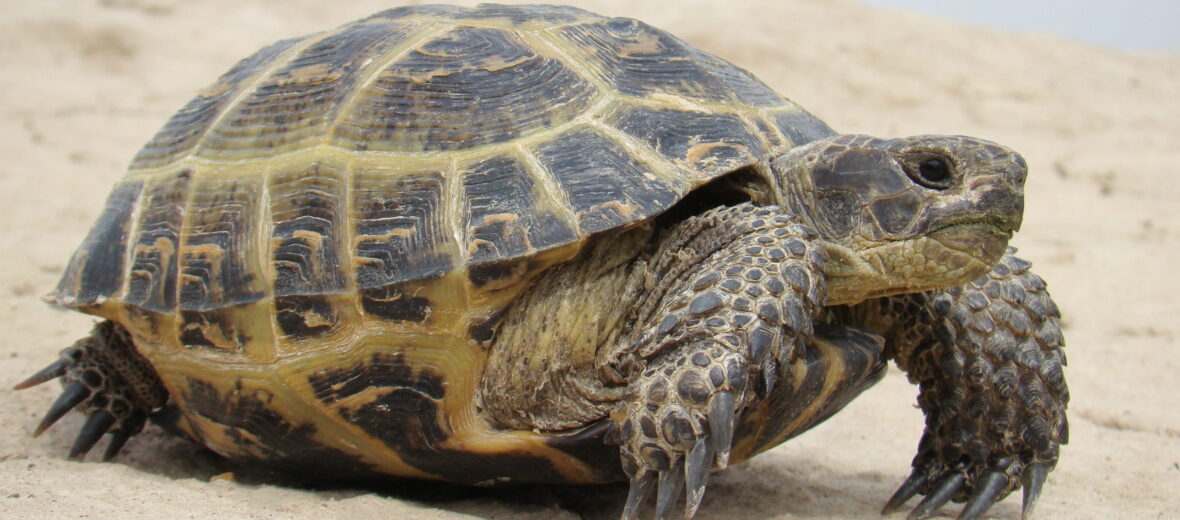
The Russian tortoise, aka Afghan tortoise, Horsfield’s tortoise, steppe tortoise, or Central Asian tortoise, hails from the Caspian Sea on south through Pakistan, Afghanistan, Iran, and east across Kazakhstan to Xinjiang, China. They prefer deserts, rocky hillsides, sandy steppes, and grassy regions close to water. These tortoises have a relatively short period of actual activity; sometimes equaling only 3 months out of the year, in the wild. The Russian tortoise is listed as Vulnerable by the IUCN. Due in part to civil unrest, hunting, collection for the pet trade (which isn’t even needed as they breed readily in captivity), and habitat destruction.
First the Stats…
Scientific name: Testudo horsfieldii
Weight: Up to 2.5 lbs.
Length: Up to 8 inches
Lifespan: Up to 50+ years
Now on to the Facts!
1.) These tortoises hibernate when it gets too cold and aestivate (see brumation page) when it gets too hot.
2.) They are typically crepuscular (active at dawn and dusk). But will exhibit diurnal (active during the day) behaviors when the temperatures are mild.
3.) Russian tortoises are often kept as pets and have great personalities.
4.) Russians build burrows up to 6+ feet deep, in which to retreat to for safety from the heat, cold, and predators.
5.) They are herbivores (eat plant matter) that graze on grasses, leaves, fruits, twigs, stems, bushes, and succulents.
But wait, there’s more on the Russian tortoise!
6.) In order to woo a lady friend, the male will perform a series of swift head bobs, and even ram into her several times in order to win her affection.
7.) The male will mount the female, and after copulation he will leave her and she will be responsible for building a nest and taking care of laying eggs.
Did you know…?
If you lightly scratch the hind portion of a tortoise’s shell (carapace), they will do a little booty shake, back and forth, till you stop.
8.) These tortoises are actually quite social and will often group together in the same burrow.
9.) A group of these tortoises is called a nest, bale, dole, turn, or creep.
10.) Females lay between 2 – 6 eggs that hatch in approximately 110 days.
But wait, there’s still more on the Russian tortoise!
11.) The Latin name “Testudinal” means “relating to a tortoise or the shell of a tortoise.”
Did you know…?
During sieges, Roman soldiers would go into a testudo formation. This was named so because of the Latin name for tortoise. They formed a series of rows and held their shields above or in front of them to completely cover the unit from arrow follies.
12.) All tortoises have an exoskeleton (outer shell) and an endoskeleton (internal skeleton). A shell has 3 primary parts: the carapace (top of their shell), the plastron (bottom of their shell, or their belly), and the bridge that joins both sections together. All tortoises have a spine, ribs, and collar bones (clavicals) inside their shell.
13.) Like all burrowing critters, they have a high tolerance for CO2, seeing as there tends to be a lot higher concentrations of carbon dioxide in their burrows.
14.) When you hear a tortoise hiss, as it brings in its external parts (including their head) into their shell, they aren’t hissing out of fear or aggression, they are doing so to make room for all their parts to be tucked into the shell. Hey, there’s only so much room in there.
15.) Russian tortoises were the first earth-based biologic to orbit the moon. That’s right. In 1968, the Russians sent 2 Russian tortoises to the moon and back.
Now a Short Russian Tortoise Video!
Be sure to share & comment below! Also, check out the Critter Science YouTube channel. Videos added frequently!
Want to suggest a critter for me to write about? Let me know here.




Leave a Reply